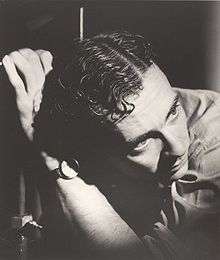Max Dupain
| Max Dupain | |
|---|---|
 Dupain in 1938 | |
| Born |
Maxwell Spencer Dupain April 22, 1911 Ashfield, Australia |
| Died | July 27, 1992 (aged 81) |
| Nationality | Australian |
| Occupation | photographer |
| Notable work | Sunbaker |
| Parents |
|
Maxwell Spencer Dupain AC (22 April 1911 – 27 July 1992) was an Australian modernist photographer.
Early life
Dupain received his first camera as a gift in 1924, spurring his interest in photography.[1] He later joined the Photographic Society of NSW, where he was taught by Justin Newlan; after completing his tertiary studies, he worked for Cecil Bostock in Sydney.
Career
Early years

By 1934 Max Dupain had struck out on his own and opened a studio in Bond Street, Sydney. In 1937, while on the south coast of New South Wales, he photographed the head and shoulders of a friend, Harold Salvage, lying on the sand at Culburra Beach. The image, entitled Sunbaker, subsequently became Dupain's most famous piece.
However, it was not until the 1970s that the photograph received wide recognition. It was purchased in 1976 by the National Gallery of Australia in Canberra and has become a national icon.[2]
Later years

During World War II Dupain served with the Royal Australian Air Force in both Darwin and Papua New Guinea helping to create camouflage.
The war affected Dupain and his photography, by creating in him a greater awareness of truth in documentary. In 1947, these feelings were reinforced when he read a book Grierson on Documentary which defined the need for photography without pretence. The catchcry was "the creative treatment of actuality". Dupain was keen to restart the studio with this new perspective and abandon what he called the "cosmetic lie of fashion photography or advertising illustration". Refusing to return to the "cosmetic lie" of advertising, Dupain said:
"Modern photography must do more than entertain, it must incite thought and by its clear statements of actuality, cultivate a sympathetic understanding of men and women and the life they live and create."
Dupain's documentary work of this period is exemplified in his photograph "Meat Queue". He used a more naturalistic style of photography, "capturing a moment of everyday interaction [rather than] attempting any social comment".[3]
Dupain also worked extensively for the University of New South Wales[4] and CSR Limited and made many trips to the interior and coast of northern Australia. However, apart from his war service he rarely left Australia, the first time not until 1978, when he was 67, and even then it was to photograph the new Australian Embassy in Paris, designed by his longtime friend and associate Harry Seidler.[5] He wrote, "I find that my whole life, if it is going to be of any consequence in photography, has to be devoted to that place where I have been born, reared and worked, thought, philosophised and made pictures to the best of my ability. And that's all I need".[6]
In the 1950s the advent of the new consumerism meant that there was plenty of promotional photography for advertising and he attracted clients from magazines, advertising agencies and industrial firms. In between this he devoted time to pursue his love of architecture, and began architectural photography, which he continued most of his life.
Personal life
In 1939, after the outbreak of World War II, Dupain married Olive Cotton (also a photographer) but they divorced soon after. A decade later, Dupain married Diana Illingworth and subsequently they had a daughter Danina and a son Rex, who also became a photographer.
Dupain was given an OBE in the New Year's honours list, 1981.[7][8]
Dupain continued working until his death in 1992.
References
- ↑ "Max Dupain". Tristans Gallery. Retrieved 23 February 2010.
- ↑ Max Dupain (1937). "Sunbaker". National Gallery of Australia. Retrieved 25 November 2008.
- ↑ Max Dupain (1946). "Meat Queue". National Gallery of Australia. Retrieved 25 November 2008.
- ↑ O'Farrell, Patrick (1999). "3". UNSW - A Portrait. University of New South Wales Press Ltd. p. 116. ISBN 0-86840-617-1. Retrieved 24 November 2008.
- ↑ Richard Yallop, "The pleasures of Dupain", The Weekend Australian, 23-24 September 2000
- ↑ Sebastian Smee, "On the beach", Good Weekend magazine, Sydney Morning Herald, 21 October 2000
- ↑ "It's an Honour - Honours - Search Australian Honours". It's an Honour. Retrieved 11 June 2016.
- ↑ "It's an Honour - Honours - Search Australian Honours". It's an Honour. Retrieved 11 June 2016.
Bibliography
- Max Dupain’s Australian Landscapes, Mead and Beckett, Australia, 1988.
- Fine Houses of Sydney, Irving Robert; Kinstler John; Dupain Max, Methuen, Sydney, 1982.
- Max Dupain Photographs published by Ure Smith, Sydney, 1948.
External links
| Wikimedia Commons has media related to Max Dupain. |
- "Sunbaker" page at National Gallery of Australia site
- Max Dupain exhibition photography site
- National Library of Australia, Canberra (Max Dupain's Life & Career 1929-1992)